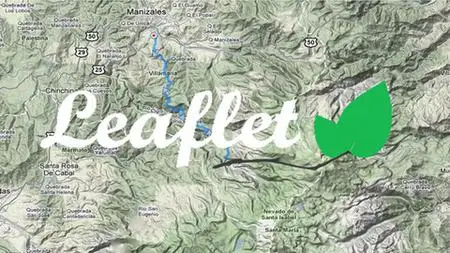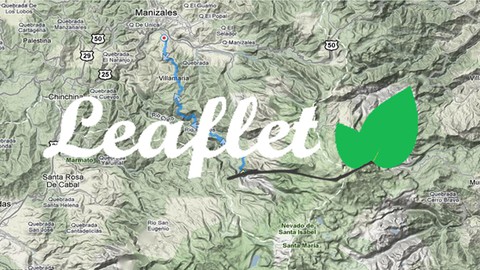Leaflet From Scratch With A Geodjango Project
Published 1/2023
MP4 | Video: h264, 1280x720 | Audio: AAC, 44.1 KHz
Language: English | Size: 7.83 GB | Duration: 17h 40m
Published 1/2023
MP4 | Video: h264, 1280x720 | Audio: AAC, 44.1 KHz
Language: English | Size: 7.83 GB | Duration: 17h 40m
Master Leaflet (JavaScript web mapping library), GeoDjango, Django REST, PostGIS, and build web mapping applications
What you'll learn
All the Key Concepts of Leaflet
Vector Layers in Leaflet including points, polylines, polygons, GeoJSON layers, markers, scalable vector graphics
Styling Vector layers including basic styling, event based styling and others
Raster layers, WMS and WFS layers
Managing layers in Leaflet including GeoJSON
Map projections and Coordinate Reference Systems
Map controls and interactions
Custom Leaflet plugin development
Full stack web-GIS development with Leaflet, Django, GeoDjango, Django REST Framework, and PostGIS
Learn and Build a Complete Web-GIS Project with Leaflet, Django, GeoDjango, Django REST Framework, and PostGIS
And much much more
Requirements
Basics of HTML, CSS and JavaScript
Description
Leaflet is an open source JavaScript front-end library that can be used to build interactive web mapping applications.This course focuses on the latest version of the Leaflet (the course was recorded in 2023), and is the most comprehensive and modern Leaflet course you can find in UDEMY. It starts with very basics and goes all the way to advanced concepts. Once we master all the Leaflet concepts, we build a complete Leaflet project in the last section, which uses Leaflet at the front-end, and GeoDjango, Django REST framework and PostGIS at the back-end. For those who do not have Python programming experience, I provide a crash course on Python that covers the concepts you will need in the project development.By the end of this course, you can build amazing web mapping applications using Leaflet.More details about what the course coversIntroduction to Leaflet librarySetting up the environmentSimple mapIntroduction to key concepts and components of LeafletVector Layers in Leaflet including points, polylines, polygons, GeoJSON layers, markers, scalable vector graphicsStyling Vector layers including basic styling, event based styling and othersRaster layers, WMS and WFS layersManaging layers in Leaflet including GeoJSONProjections and Coordinate Reference Systems including different projections, coordinate transformations, and reprojecting of geospatial dataMap controls and interactionsCustom Leaflet plugin developmentA crash course on Python (optional)Full stack web-GIS development with Leaflet, Django, GeoDjango, Django REST Framework, and PostGISAnd much more!
Overview
Section 1: Getting started
Lecture 1 Setting up a work environment
Lecture 2 First Leaflet Map
Lecture 3 Debugging techniques
Section 2: Key concepts in Leaflet
Lecture 4 Central Leaflet Map Class - Overview
Lecture 5 Map controls
Lecture 6 Raster layers
Lecture 7 Vector layers
Section 3: Leaflet Map Object
Lecture 8 Leaflet Map Class Options
Lecture 9 Leaflet Map Class Events - Geolocation API
Lecture 10 Leaflet Map Class Methods
Lecture 11 Leaflet Map Class Properties
Section 4: Vector layers
Lecture 12 Geographical location - longitude and latitude
Lecture 13 Custom marker icon - Part 1
Lecture 14 Custom marker icon - Part 2
Lecture 15 Drawing polylines dynamically - Part 1
Lecture 16 Drawing polylines dynamically - Part 2
Lecture 17 Polyline options
Lecture 18 Drawing polygons dynamically - Part 1 (A Leaflet plugin development)
Lecture 19 Drawing polygons dynamically Part 2 (A Leaflet plugin development)
Lecture 20 Drawing polygons dynamically - Part 3 (A Leaflet plugin development)
Lecture 21 Rectangle overlays
Lecture 22 Circle overlays
Lecture 23 SVG - Scalable Vector Graphics (Part 1)
Lecture 24 SVG - Scalable Vector Graphics (Part 2)
Section 5: Grouping Layers in Leaflet and GeoJSON
Lecture 25 LayerGroup - Part 1
Lecture 26 LayerGroup - Part 2
Lecture 27 FeatureGroup
Lecture 28 GeoJSON - Part 1
Lecture 29 GeoJSON - Part 2
Lecture 30 GeoJSON - Part 3
Section 6: Styling Vector Layers
Lecture 31 Basic styling of point features
Lecture 32 Event based styling
Lecture 33 Styling point features using a pointToLayer function
Lecture 34 Styling lines
Lecture 35 Styling polygons - Part 1
Lecture 36 Styling polygons - Part 2
Lecture 37 Layer order - Part 1
Lecture 38 Layer order - Part 2
Section 7: Raster Layers, WMS Layer and WFS Layer
Lecture 39 Video Overlay
Lecture 40 WMS Layer - Part 1
Lecture 41 WMS Layer - Part 2
Lecture 42 WFS Layer - Part 1
Lecture 43 WFS Layer - Part 2
Section 8: Map Projections and Coordinate Reference System (CRS)
Lecture 44 Map projections and CRS - Introduction
Lecture 45 Map Projections and CRS basics
Lecture 46 Extending projections and CRS support in Leaflet with Proj4Leaflet - Part 1
Lecture 47 Extending projections and CRS support in Leaflet with Proj4Leaflet - Part 2
Lecture 48 Map projection methods in Leaflet
Section 9: Map controls and Leaflet Plugins
Lecture 49 Leaflet Draw Plugin
Lecture 50 Leaflet Cluster Plugin
Section 10: Leaflet Miscellaneous
Lecture 51 Leaflet miscellaneous - part 1
Lecture 52 Leaflet miscellaneous - part 2
Section 11: Python Language Fundamentals (optional)
Lecture 53 Python introduction and installation
Lecture 54 Python executing code
Lecture 55 Python indentation
Lecture 56 Python comments
Lecture 57 Python variables - part 1
Lecture 58 Python variables - part 2
Lecture 59 Python strings - introduction
Lecture 60 Python string slicing
Lecture 61 Python string formatting
Lecture 62 Python lists - introduction
Lecture 63 Python lists - changing and adding items
Lecture 64 Python lists - removing list items
Lecture 65 Python list comprehension - part 1
Lecture 66 Python list comprehension - part 2
Lecture 67 Python tuples - introduction
Lecture 68 Python tuples - accessing, changing, adding, and removing items
Lecture 69 Python sets - introduction
Lecture 70 Python sets - adding and removing items
Lecture 71 Python sets - math operations on sets
Lecture 72 Python dictionaries - introduction
Lecture 73 Python dictionaries - accessing, adding, and removing items
Lecture 74 Python operators
Lecture 75 Python If, Elif, and Else statements
Lecture 76 Python ternary operators
Lecture 77 Python while Loop
Lecture 78 Python for loop
Lecture 79 Python functions - introduction
Lecture 80 Python functions - standard, positional, and keyword arguments (part 1)
Lecture 81 Python functions - standard, positional, and keyword arguments (part 2)
Lecture 82 Python scope
Lecture 83 Python classes - introduction
Lecture 84 Python classes - inheritance
Section 12: Project Chapter 1 - Setting up Django, GeoDjango, PostGIS and psycopg2
Lecture 85 Project Intro
Lecture 86 Setting up a Django project
Lecture 87 Setting up Django apps
Lecture 88 Setting up GeoDjango
Lecture 89 Setting up PostGIS database
Lecture 90 Installing psycopg2
Lecture 91 Linking the apps to the project, first migration, and creating a superuser
Section 13: Project Chapter 2 - GeoDjango database models and the admin interface
Lecture 92 Creating database models
Lecture 93 Foreign key and media folder
Lecture 94 Installation of Pillow, database model migration, and Django admin interface
Lecture 95 Creating records using Django admin interface
Section 14: Project Chapter 3 - GeoDjango views, URLs and geojson serialization
Lecture 96 Introduction to Django views and urls
Lecture 97 Introduction to serialization and Django database queries (part 1)
Lecture 98 Introduction to serialization and Django database queries (part 2)
Section 15: Project Chapter 4 - Django REST Framework and geospatial data
Lecture 99 Introduction Django REST Framework and serialization
Lecture 100 Category model - RetrieveAPIView
Lecture 101 Places model - ListAPIView
Lecture 102 Places - RetrieveAPIView
Lecture 103 Implementing a view that returns the nearest 3 cities to the place (Part - 1)
Lecture 104 Implementing a view that returns the nearest 3 cities to the place (Part - 2)
Lecture 105 Permission and throttling
Lecture 106 Login and format suffixes
Section 16: Project Chapter 5 - Front-end development in GeoDjango and Leaflet
Lecture 107 Setting up a front-end views, urls, and templates
Lecture 108 Django static files
Lecture 109 Leaflet map in Django
Lecture 110 Adding GeoJSON places to the map
Lecture 111 Changing the default places markers to circle markers
Lecture 112 Setting the distinct style for the selected place
Lecture 113 Places popup window and text
Lecture 114 Styling the map template
Lecture 115 Updating the menu information
Lecture 116 Adding the nearby three cities to the Leaflet map
Lecture 117 Adding the nearby three cities to the Leaflet map (Part - 2)
Lecture 118 Cities popup window and text
Section 17: Next steps
Lecture 119 Congratulations and Next steps
People that want to learn web mapping using Leaflet,People interested in developing a web-GIS apps with Leaflet, Django, GeoDjango, Django REST framework, and PostGIS,GIS (Geographic Information Science) professionals and students



